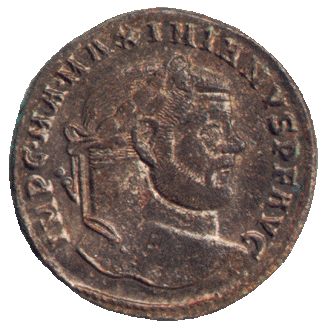 Contents -
Previous Article -
Next Article
Contents -
Previous Article -
Next Article
In the late Third Century, a bloody revolt broke out in Gaul among the Bacaudae, poor and oppressed Gaulish peasants. The Roman emperor Diocletian sent Maximianus, a tough, battle-hardened general like himself to put down the rebellion. Maximianus soon restored order to the province and thereby showed that he was suited for the next task his emperor had for him, that of co - emperor in the West.
During the Third Century, it had been shown time after time that the form of imperial government that existed in the Roman Empire at the time was not suitable for governing a huge empire with many dangerous enemies to the North and East. Additionally, the emperor often had rebellions and internal troubles to deal with at the same time as he was fighting enemy invasions. When Diocletian ascended the throne, he realized that major changes had to be made if the empire were to survive.
Accordingly, he decided to appoint another Augustus, or emperor to help him rule. Diocletian chose as his co-emperor the able Maximianus, a native of Illyria like himself. Maximianus was given the West to rule and Diocletian retained control over the East.
Diocletian also wanted to ensure that there would be a smooth transfer of power after he was no longer emperor instead of the usual period of power struggles and unrest that came about after an emperor died or was murdered. To accomplish this, he instituted the Tetrarchy, meaning a rule by four. The two emperors or Augusti would each appoint a Caesar, or junior emperor-in-training to help him govern and to learn how to manage the government after the senior Augustus was gone. The plan was to have Maximianus and Diocletian rule for twenty years and then abdicate, allowing the Caesars to become Augusti in their place. To fill the roles of Caesar, Diocletian chose Galerius and Maximianus chose Constantius Chlorus.
The four men maintained their headquarters in different cities, two in the West and two in the East. Diocletian set up his court in Nicomedia and Maximianus ruled from Milan, Galerius chose Thessalonika and Constantius Chlorus chose Trier in what is now modern Germany. Significantly, none of the four men chose Rome as his capital. The economic and political focus of the Roman Empire had shifted from its center to its wealthy and powerful provinces.
During Maximianus' reign, a dangerous revolt broke out in Britain. In A. D. 287 Carausius, who was supposed to be hunting down pirates who had been attacking towns along the coast decided to rebel and set up his own British Empire. Carausius was killed in 293 by Allectus who ruled until Constantius Chlorus defeated him in a quick campaign in 296.
When it came time for both the senior Augusti to abdicate in A. D. 305, Diocletian was quite willing but Maximianus had become used to absolute power and only stepped down after pressure from Diocletian. The two new Augusti each chose a new Caesar. Constantius chose Severus II and Galerius chose Maximinus II Daia.
With Diocletian gone, so were his strong leadership qualities that had made the Tetrarchy work so well. Constantius died in A. D. 306 and immediately the British troops elevated his son Constantine I to the throne. To avoid another civil war and a return to the anarchy of the Third Century, Galerius compromised and named Constantine as Caesar while Severus II became the new Augustus. Furthermore, Galerius decided to tax the citizens of Rome, who had been exempt from taxes ever since the days of the Republic. Immediately, the citizens of Rome rose in rebellion and chose Maxentius, the popular son of Maximianus as their emperor. Maxentius invited his father to return to help him rule, and Maximianus was on the throne once again. Galerius sent Severus to put down the insurrection but Maxentius bribed Severus’ troops to desert him. Severus' army was soon defeated and Severus was himself captured and put to death.
The rebels were quite successful and soon Constantine had thrown his support behind them. He was raised to the rank of Augustus. Now, the Roman Empire was ruled by four Augusti and one Caesar. Galerius and his Caesar Maximinus in the East were arrayed against Maximinus, Maxentius, and Constantine in the West. During the brief period after Maxentius and Maximianus had rebelled and while Severus was still alive there were actually six men ruling various parts of the empire. Maxentius was soon arguing with his son, so Maximianus joined with Constantine against his son. Now, three factions were set to battle it out on Roman territory.
It began to look like the pattern of civil wars of the Third Century was to be repeated, so in A. D. 308 the old soldier Diocletian decided to come out of retirement and hold a peace conference in the city of Carnuntum on the Danubian frontier. According to the terms, Maximianus would again abdicate and Constantine was demoted back to Caesar. Licinius was made Augustus in the West and Maxentius was declared an enemy of the state.
In A. D. 310, Maximianus rebelled against Constantine and again declared himself Augustus. He really didn't stand a chance but held out for a few weeks behind the walls of the fortress of Massilia. When Constantine captured the old man, he really didn't want to do him any harm, but leaving Maximianus alive would provide an excuse for future rebellions. Reluctantly, he had Maximianus executed in A. D. 310.
Go to next article on Galerius
Go back to previous article on Emperor Diocletian